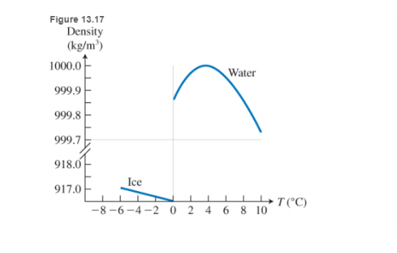
Concept explainers
Lakes freeze from top down we all know that ice cubes float in a glass of water. Why? Virtually every substance contracts when it solidifies—the solid is denser than the liquid. If this happened to water. Ice cubes would sink to the bottom of a glass, and ice sheets would sink to the bottom of a lake. Fortunately, this doesn't happen. Liquid water expands by
But this is not the only special thing about water. While the density of most substances increases when they are cooled, water density shows a very peculiar temperature dependence (see Figure 13.17). As the temperature decreases, water density increases, but only until
Note that if water were most dense at the freezing point, then in the winter the very cold water at the surface of lakes would sink in this case the lake would freeze from the bottom up, and an life in it would be destroyed.

The expansion of water when it freezes has another important environmental benefit the so-called freeze-thaw effect on sedimentary rocks. Water is absorbed into cracks in these rocks and men freezes in cold weather. The solid ice expands and cracks me rock like a wood-cutter splitting logs. This continual process of liquid water absorption, freezing, and cracking releases mineral and nitrogen deposits into me soil and can eventual break the rock down into soil.
Using Newton’s second law, expressions for buoyant force and other forces, and the densities of liquid and solid water at
a. 0.84
b. 0.88
c. 0.92
d. 0.96
e. 1.00
Want to see the full answer?
Check out a sample textbook solution
Chapter 13 Solutions
College Physics: Explore And Apply, Volume 2 (2nd Edition)
Additional Science Textbook Solutions
College Physics: A Strategic Approach (3rd Edition)
Chemistry (7th Edition)
Applications and Investigations in Earth Science (9th Edition)
Chemistry: A Molecular Approach (4th Edition)
Chemistry: Structure and Properties (2nd Edition)
Human Biology: Concepts and Current Issues (8th Edition)
- Two objects get pushed by the same magnitude of force. One object is 10x more massive. How does the rate of change of momentum for the more massive object compare with the less massive one? Please be able to explain why in terms of a quantitative statement found in the chapter.arrow_forwardA box is dropped on a level conveyor belt that is moving at 4.5 m/s in the +x direction in a shipping facility. The box/belt friction coefficient is 0.15. For what duration will the box slide on the belt? In which direction does the friction force act on the box? How far will the box have moved horizontally by the time it stops sliding along the belt?arrow_forwardNo chatgpt pls will upvotearrow_forward
- No chatgpt pls will upvotearrow_forwardA toy car speeds up at 1.0 m/s2 while rolling down a ramp, and slows down at a rate of 2.0 m/s2 while rolling up the same ramp. What is the slope of the ramp in degrees? Grade in %? The friction coefficient?arrow_forwardPlz solution should be complete No chatgpt pls will upvote .arrow_forward
- A box with friction coefficient of 0.2 rests on a 12 foot long plank of wood. How high (in feet) must one side of the plank be lifted in order for the box to begin to slide?arrow_forwardWhat is a good general rule to follow in order to find the best choice of coordinate system to solve a dynamics problem?arrow_forwardWhat is the meaning of a first order approximation?arrow_forward

 Physics for Scientists and Engineers: Foundations...PhysicsISBN:9781133939146Author:Katz, Debora M.Publisher:Cengage Learning
Physics for Scientists and Engineers: Foundations...PhysicsISBN:9781133939146Author:Katz, Debora M.Publisher:Cengage Learning College PhysicsPhysicsISBN:9781938168000Author:Paul Peter Urone, Roger HinrichsPublisher:OpenStax College
College PhysicsPhysicsISBN:9781938168000Author:Paul Peter Urone, Roger HinrichsPublisher:OpenStax College College PhysicsPhysicsISBN:9781305952300Author:Raymond A. Serway, Chris VuillePublisher:Cengage Learning
College PhysicsPhysicsISBN:9781305952300Author:Raymond A. Serway, Chris VuillePublisher:Cengage Learning College PhysicsPhysicsISBN:9781285737027Author:Raymond A. Serway, Chris VuillePublisher:Cengage Learning
College PhysicsPhysicsISBN:9781285737027Author:Raymond A. Serway, Chris VuillePublisher:Cengage Learning Glencoe Physics: Principles and Problems, Student...PhysicsISBN:9780078807213Author:Paul W. ZitzewitzPublisher:Glencoe/McGraw-Hill
Glencoe Physics: Principles and Problems, Student...PhysicsISBN:9780078807213Author:Paul W. ZitzewitzPublisher:Glencoe/McGraw-Hill





